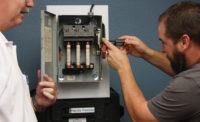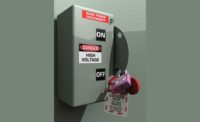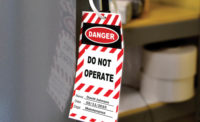Smartphone, tablets & lockout-tagout
View electronic images of energy isolation points

OSHA’s General Industry’s standard for the Control of Hazardous Energy (LOTO) 29 CFR 1910.147 addresses one of the most important safety regulations to protect workers from injury: lockout/tagout. The standard requires workers to isolate energy during servicing and maintenance of machines and equipment to prevent the unexpected startup or release of energy. 2018 marked the 30th anniversary of the standard published in the Federal Register on April 29, 1988.
Over the past 30 years, lockout/tagout (LOTO) has been one of the most-cited regulations in general industry. The impact on companies not following the requirements of this standard can be devastating with injuries, fatalities, and citations. The LOTO standard was number five on the top ten list of OSHA citations in 2017. One of the most common citations of the LOTO standard is 29 CFR 1910.147(C)(4) Energy Control Procedure (ECP). This standard requires the employer to develop machine-specific ECPs.
LOTO goes digital
Throughout the past several years, safety professionals and employers have entered the digital age, leveraging technology in order to more effectively manage their safety programs. LOTO is no exception to this movement towards utilizing technology to facilitate in the management of the elements in this program. Implementing software to create ECPs provides several benefits such greater efficiency on the creation of ECPs and higher quality control to ensure compliance with the LOTO program.
When utilizing software to create ECPs, numerous options are available to stay compliant with OSHA’s standards. Employees are able to use their smartphones or tablets to view electronic versions of the ECPs. Electronic versions of the energy control procedure allow employees to have the most current revisions. Additionally, monitoring the maintenance and condition of the equipment is simplified by using the software and ensures annual review of required inspections of the ECP. This can occur within the software or by linking the electronic copies to preventive maintenance software or other asset management tool.
Identify energy isolation points
In order to create a compliant energy control procedure, section 19010.147 (Appendix A) addresses four minimum implementations. These procedures include Purpose, Scope of Compliance With This Program, Sequence of Lockout, and Restoring Equipment to Service. Within these elements, the most crucial is the Sequence of Lockout. This procedure covers the who, what, when, where, and how of the ECP. In order to create the Sequence of Lockout for the ECP, each piece of equipment evaluated must have the Energy Isolation Points identified. It is a best practice to ensure there is someone familiar with the equipment to ensure the correct energy isolation points and correct magnitude of energy are identified.
Identifying Energy Isolation Points within the energy control procedure is crucial. The most common procedure is to install a tag at the energy isolation point and reference the tag number in the ECP. Employees should also upload an image of the energy isolation point using the electronic tablet provided.
For example, if a piece of equipment has two electrical sources and two pneumatic sources, the identification tags should indicate E-001, E-002, P-001, and P-002. The identification tag numbers are to be individually inputted to the machine’s specific ECP to identify each energy source and the order of isolation. Using a standard numbering system is a great way to ensure each source is identified to the corresponding step on the ECP; however, it is important to ensure that numbers are not duplicates. If an energy isolation point tag number is utilized more than once, an employee performing maintenance could then isolate the wrong energy source.
Updating & tracking revisions
Once identifying the energy isolation points and steps to isolate the equipment, ECPs are built much easier. One of the most beneficial attributes of using software is that when changes are made to the layout or additional information is input to the ECP, a global change can occur very quickly. A database holds all ECPs information; therefore, any updates or modification to the master template of the Purpose, Scope of Compliance with The Program, or Restoring Equipment to Service can occur instantaneously. Additionally, the software has tracking capabilities of every revision to the ECP, which the annual inspection process to be easily documented.
Evaluating what needs have to be met for the right lockout/tagout software can be an overwhelming task. Best practice is to develop a scope of what is needed from the software and what the ultimate goals are. Bringing software into your lockout/tagout program will ensure the capability to track the proper standards to ensure LOTO compliance and more importantly that employees are kept safe.
Looking for a reprint of this article?
From high-res PDFs to custom plaques, order your copy today!






